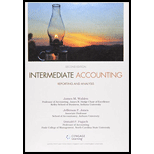
Intermediate Accounting: Reporting and Analysis (Looseleaf)
2nd Edition
ISBN: 9781285453859
Author: WAHLEN
Publisher: Cengage
expand_more
expand_more
format_list_bulleted
Concept explainers
Question
Chapter 20, Problem 15E
1.
To determine
Prepare the journal entries for the seller-lessee Company S, for 2016 to reflect the ales and lease back agreement.
2.
To determine
Discuss the accounting treatment of the gain by the seller-lessee and prepare the
Expert Solution & Answer
Want to see the full answer?
Check out a sample textbook solution
Students have asked these similar questions
Ultimate Production manufactures radon detectors. The standard for materials for each detector is 4 pounds of acrylic at a standard cost of $7.30 per pound. During May, the company purchased 975 pounds and used 885 pounds of acrylic, and made 410 radon detectors. The company paid $4.45 per pound for the acrylic. There were 5100 detectors budgeted for May. How much is the material quantity variance?
Please given correct answer for General accounting question I need step by step explanation
Shakira Electronics has received a special one-time order for 900 light bulbs at $7 per unit. Shakira currently produces and sells 10,000 units at $8.00 each. This level represents 80% of its capacity. The production costs for these units are $6 per unit, which includes a $4 variable cost and a $2 fixed cost. To produce the special order, a new machine needs to be purchased at a cost of $1,200 with a zero-salvage value. Management expects no other changes in costs as a result of the additional production. If Shakira wishes to earn $1,500 on the special order, the size of the order would need to be?
Chapter 20 Solutions
Intermediate Accounting: Reporting and Analysis (Looseleaf)
Ch. 20 - Prob. 1GICh. 20 - What is the difference between the lessee and...Ch. 20 - Prob. 3GICh. 20 - Prob. 4GICh. 20 - Prob. 5GICh. 20 - Prob. 6GICh. 20 - What are the two types of lease classifications...Ch. 20 - Prob. 8GICh. 20 - Prob. 9GICh. 20 - Prob. 10GI
Ch. 20 - Prob. 11GICh. 20 - Describe the difference between how a lessee would...Ch. 20 - Prob. 13GICh. 20 - Prob. 14GICh. 20 - Prob. 15GICh. 20 - Prob. 16GICh. 20 - Prob. 17GICh. 20 - Prob. 18GICh. 20 - Prob. 19GICh. 20 - Prob. 20GICh. 20 - Prob. 21GICh. 20 - Prob. 1MCCh. 20 - Prob. 2MCCh. 20 - Prob. 3MCCh. 20 - Prob. 4MCCh. 20 - Prob. 5MCCh. 20 - Prob. 6MCCh. 20 - Prob. 7MCCh. 20 - Prob. 8MCCh. 20 - Rent received in advance by the lessor for an...Ch. 20 - Prob. 10MCCh. 20 - Next Level Keller Corporation (the lessee) entered...Ch. 20 - Prob. 2RECh. 20 - Prob. 3RECh. 20 - Prob. 4RECh. 20 - Prob. 5RECh. 20 - Prob. 6RECh. 20 - Prob. 7RECh. 20 - Prob. 8RECh. 20 - Prob. 9RECh. 20 - Prob. 10RECh. 20 - Prob. 1ECh. 20 - Prob. 2ECh. 20 - Lessee Accounting Issues Sax Company signs a lease...Ch. 20 - Prob. 4ECh. 20 - Prob. 5ECh. 20 - Prob. 6ECh. 20 - Prob. 7ECh. 20 - Lessor Accounting with Receipts at Beginning of...Ch. 20 - Determining Type of Lease and Subsequent...Ch. 20 - Prob. 10ECh. 20 - Prob. 11ECh. 20 - Prob. 12ECh. 20 - Prob. 13ECh. 20 - Prob. 14ECh. 20 - Prob. 15ECh. 20 - Determining Type of Lease and Subsequent...Ch. 20 - Prob. 2PCh. 20 - Prob. 3PCh. 20 - Lessee Accounting Issues Timmer Company signs a...Ch. 20 - Prob. 5PCh. 20 - Prob. 6PCh. 20 - Sales-Type Lease with Receipts at End of Year...Ch. 20 - Prob. 8PCh. 20 - Prob. 9PCh. 20 - Prob. 10PCh. 20 - Prob. 11PCh. 20 - Prob. 12PCh. 20 - Prob. 13PCh. 20 - Prob. 14PCh. 20 - Prob. 15PCh. 20 - Prob. 1CCh. 20 - Prob. 2CCh. 20 - Prob. 3CCh. 20 - Classification of Leases Part a. Capital leases...Ch. 20 - Prob. 5CCh. 20 - Prob. 6CCh. 20 - Prob. 7CCh. 20 - Prob. 8CCh. 20 - Prob. 9CCh. 20 - Prob. 10CCh. 20 - Prob. 11CCh. 20 - Prob. 12CCh. 20 - Prob. 13CCh. 20 - Prob. 14CCh. 20 - Prob. 15C
Knowledge Booster
Learn more about
Need a deep-dive on the concept behind this application? Look no further. Learn more about this topic, accounting and related others by exploring similar questions and additional content below.Similar questions
- Tom Manufacturing Corp. desires a weighted average cost of capital of 8%. The firm has an after-tax cost of debt of 5% and a cost of equity of 14%. What debt-equity ratio is needed for the firm to achieve its targeted weighted average cost of capital? A. 0.25 B. 0.50 C. 1.50 D. 2.00 E. 3.00arrow_forwardprovide solution of this question with general accountingarrow_forwardSubject - General accountarrow_forward
- I want to this question answer for General accounting question not need ai solutionarrow_forwardAccounting question with correctarrow_forwardHow does operational efficiency measurement differ from financial metrics? a) Process effectiveness indicators complement cost measures b) Financial data tells complete story c) Efficiency remains constant d) Standard metrics work everywhere answerarrow_forward
arrow_back_ios
SEE MORE QUESTIONS
arrow_forward_ios
Recommended textbooks for you
 Intermediate Accounting: Reporting And AnalysisAccountingISBN:9781337788281Author:James M. Wahlen, Jefferson P. Jones, Donald PagachPublisher:Cengage Learning
Intermediate Accounting: Reporting And AnalysisAccountingISBN:9781337788281Author:James M. Wahlen, Jefferson P. Jones, Donald PagachPublisher:Cengage Learning

Intermediate Accounting: Reporting And Analysis
Accounting
ISBN:9781337788281
Author:James M. Wahlen, Jefferson P. Jones, Donald Pagach
Publisher:Cengage Learning
Accounting for Finance and Operating Leases | U.S. GAAP CPA Exams; Author: Maxwell CPA Review;https://www.youtube.com/watch?v=iMSaxzIqH9s;License: Standard Youtube License